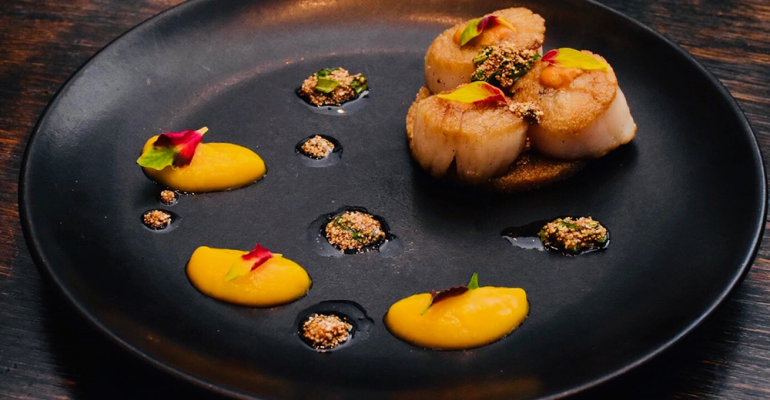From many points of view, 1992 was an outstanding year. The Cold War was declared officially at an end, and Microsoft released Windows 3.1, the platform that enabled desktop publishing. Nirvana shook up the music world with Smells Like Teen Spirit, and The Silence of the Lambs nabbed the Oscar for best picture.
Notable achievements all, they pale somewhat in comparison to the extraordinary gastronomic shocker reported that year in the New York Times, namely that “ketchup, long the king of condiments, has been dethroned.” The source of this unexpected upset was salsa, which one food analyst in the story boldly declared to be as mainstream as apple pie.
The report was perhaps the first indication of the oncoming wave of culinary crossover of foods and ingredients from outside the mainstream that would permanently alter the way Americans eat. The familiar Mexican condiment has long since assumed the status of staple, of course, and while it remains a red, and occasionally green, fixture on lots of menus, many chefs are going beyond the familiar to explore its true potential.
Regional and authentic
Salsa is subject to wide ranging variations based on region of origin, the chef or even the home cook who created it, and more menus here reflect those alternatives. In Costa Mesa, Calif., Taco María, a Michelin-starred and James-Beard-Award recognized restaurant, offers Calabazas con Sikil Pak, seasonal squash with salsa de semillas, or seeds, that typically include pumpkin and sesame. Up the coast in Los Angeles, Broken Spanish has won plaudits and a Michelin nod for specials like quesadilla with oxtail, plantain and salsa quemada, a sauce made smoky and rich with roasted tomatoes. Leña Brava in Chicago features ceviche accented with spicy hazelnut salsa macha, a variation on a standard from Veracruz.
Speaking of smoke and Veracruz, morita is a chile variety that is popular there and popping up here. A first cousin to chipotle, morita is also a smoked jalapeño, but lighter smoking gives it a fruitier finish. This works to its advantage in dishes like the octopus tostada at Black Market in Indianapolis, which comes with morita salsa aïoli, pickled onion, avocado and black beans. Antique Taco in Chicago purveys ‘farmers’-market-style” tacos like one with grilled steak topped with morita salsa, arugula, onion, lime, queso and cilantro.
Also in Chicago, popular Big Star creates a vegetarian option with The Walking Taco — a cousin of the Frito pie of Texas — made with corn chips, spicy pinto-bean dip and salsa Tamazula, an homage to a well-known salsa brand from the state of Jalisco.
Supremo, an Atlanta-based taqueria, pays homage of a different sort; its carne asada taco comes with salsa albañil made with avocado and queso fresco and named for the laborers who favored it (“albañil” is Spanish for “builder”).
Fruit forward and fanciful
Other chefs have moved farther afield with fruit-based salsas that brighten the items they accompany. This is the case at Plado Tasting Bar in New York City, where Norwegian salmon is served with citrus salsa and avocado. At Flora Street Cafe in Dallas, the fall menu features crispy pork belly balanced by an acidic cranberry salsa. A similar balancing act goes on at Broken Spanish in Los Angeles, where the roasted chicken comes with pomegranate salsa.
Flights of fancy in the salsa department include the cashew salsa appetizer at Taqueria in New York City’s West Village, which is served with chips, as well as that restaurant’s pastrami taco with mustard-seed salsa. Nearby Babs restaurant fuses European and Mexican influences in dishes like charcoal-grilled swordfish topped with mint salsa verde.
And in Fairfax, Va., Taco Bamba offers the very model of the modern menu mashup. The Robinson Ramen Taco comprises noodles, shoyu carnitas, canned corn, togarashi tartar and salsa Machado, created by baseball player Manny Machado, who started his major league career with the Baltimore Orioles.
Not just salsa
Another Mexican staple, mole, is being reinvented, too. The classic range of sauces with pre-Hispanic roots has lately been the subject of contemporary reinterpretation. At Poca Madre in Washington, D.C., the day boat scallops sport butternut-pineapple mole, while at Empellón in New York City, A-5 wagyu fajitas are accented by black pepper mole. Special mention must be made, however, of Miss Ada in Brooklyn. The restaurant creates a Mediterranean-with-a-twist menu that includes short ribs plated with Israeli mole, a combination of Middle Eastern spices, harissa and chocolate.
Nancy Kruse, president of the Kruse Company, is a menu trends analyst based in Atlanta. As one of LinkedIn’s Top 100 Influencers in the U.S., she blogs regularly on food-related subjects at linkedin.com.





